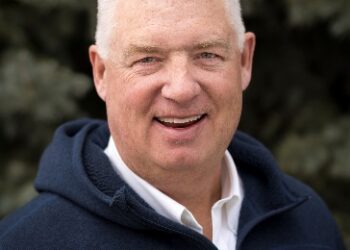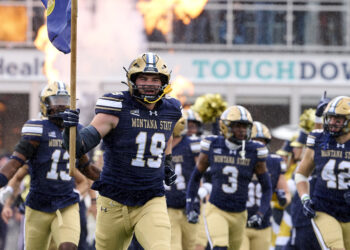The Buffalo Bill Historical Center in Cody integrates Western heritage, natural science and the arts
By Emily Stifler Explorebigsky.com Managing Editor
CODY, Wyo. – Hundreds of rifles are lined up in glass cases in the Cody Firearms Museum, and to the untrained eye it’s hard to tell them apart. But Bruce Eldredge knows each one has a story.
“You see there’s an engraving on this one,” he says, pointing. “It was given to a particular person who carried it in the Civil War and was killed in the battle of Atlanta.”
That kind of story, the museum CEO and director says, can help illuminate the firearms experience in this country and give us a greater understanding of both the American West and the national character.
The museum is largest of its kind and has the most comprehensive assembly of American firearms in the world.
“If you ever wanted it as a rifle, it’s here,” Eldredge said. That includes the entire Winchester arms collection, and pieces from almost every major manufacturer.
This is one of five museums in the Buffalo Bill Historical Center, alongside the Buffalo Bill Museum, the Whitney Gallery of Western Art, the Plains Indians Museum and the Draper Museum of Natural History. The facility has more than 100,000 collections, and one of the largest non-university funded research libraries in the West.
Eldredge came to the historical center five years ago from Spokane, Wash., where he was director of the Northwest Museum of Arts and Culture. He’s been directing museums for 35 years and this, he says, is his dream job.
“The NRA will tell you firearms are in our second amendment,” he says, gesturing with his glasses in the air as he talks. “But what are firearms really all about? Putting food on the table. Hunting was an important way of life in this country until 100 years ago. When it ceased to be important was when we were producing more food for commercial purposes.”
He points out Teddy Roosevelt’s shotgun and rifle, which are paired with several books authored by the former president.
“The history of conservation in the U.S. goes back to hunting,” Eldredge says. “Without conservation, there wouldn’t be hunting.” This, he says, provides a platform to discuss the interplay between art, history and science—connecting the five museums.
While there are an increasing number of museum districts in places like Dallas, San Diego, Chicago and New York, the way the Buffalo Bill center combines Western art and history with natural science is distinct, says Dewey Blanton, from the American Association of Museums.
Set near the east gate of Yellowstone National Park, the museum was founded in 1917 as a memorial for Buffalo Bill a few months after his death. With the 1959 opening of the Gallery of Western Art, it became a modern museum and today is “a mecca,” Eldredge says.
It’s also a commerce hub for Wyoming’s Bighorn Basin, according to Scott Balyo, executive director of the Cody Chamber of Commerce.
“The museum has a huge affect on the town,” Balyo said. “From the number of people it employs (approximately 130) to the fact that there are five world class museums. It’s a huge draw nationwide, and it sets Cody apart in terms of Western heritage.”
Out of 400,000 visitors that pass through the east gate to Yellowstone annually, 167,000 paid visitors stop at the historical center. That’s one of the highest percentage penetration of any tourism rates in the U.S.
But still, Eldredge says, it’s not enough. 155,000 of those are during the summer, and then during winter, when the facility is only open four days a week, they see about 1,000 visitors a month, half of which are local or regional.
Eldredge, who wears a sport coat and button down shirt, is in working on a day off. His frustration and passion are noticeable when he discusses the museum’s economics. In the past, museums were mostly supported by boards of trustees, but now, Eldredge spends most of his time fundraising. The historical center reduced its budget by $1.5 million in the last four years and has 25 fewer staff.
Plus, he says, the historical center is an anomaly in that it’s an internationally recognized museum in a very small town. A recent economic study showed no benchmark institution in the country.
“We should be in a community of three to five million,” he said.
But in spite of these challenges, the historical center is thriving, and just spent $2.75 million to restore the wing that hosts the Buffalo Bill museum. This is in large part because of its location next to Yellowstone, but also because the museum has broad appeal.
“Our friend Buffalo Bill was the first international rock star, the first person to have an international reputation as an entertainer,” Eldredge says. “So how did that shape America’s character? Europeans today still think of Buffalo Bill as a representation of the American West.”
As he walks through the Plains Indian museum, Eldredge’s voice calms. This, along with the Whitney Gallery, is perhaps the most poignant expression of emotions and feeling in the historical center, he says.
The museum recently acquired 2,200 Plains Indian pieces from the pre-reservation era and has been unpacking and cataloguing it, planning for a special exhibition. The museum also keeps ceremonial objects that will never be on exhibition, that are used by both Indian elders and education programs for Indian schools.
As he walks up to an exhibit, the case lights up. The lower the light level, the better it is for the objects, he explains.
“If you have collections you have to keep them forever,” he says. Conservation and collections care are some of the facility’s largest costs.
On his way to the Draper Museum of Natural Science, Eldredge ruminates on his job.
“I learn something new every day, from the objects that I see every day.”
In this, the newest of the historical center’s five wings, he seems most at ease. Created in 2001, the exhibit is a representation of the Greater Yellowstone ecosystem from a natural science perspective, offering an interactive way to think about the issues that face the region.
Bird sounds and other animal noises resonate throughout its multiple levels, creating a sort of multimedia nature walk. A taxidermy grizzly bear rears above a video about camping in bear country. Another display asks, “What solution do you think would work best with the wolves?”
“We’re a natural forum for [some] difficult controversial discussions, but we don’t take a side,” Eldredge says. “We just try to present what the science is saying.”
While the historical center’s rural location presents challenges, it also allows it to form valuable partnerships and get special permits that benefit its collections. The taxidermy bears in the Draper Museum, for example, were killed in Yellowstone. Because the museum’s senior curator Dr. Charles Preston has connections with the park, Fish Wildlife and Parks and the Forest Service, he knows when a bear has been killed and can make the proper requests get to it quickly for use in the museum.
“Those partnerships are key to what we do here,” Eldredge says. “They’re partnerships we have because of where we are, not just because of who we are. It would be very hard to have them if we were in New York City.”
Advice from the experts
Big Sky’s interest in the Montana Cowboy Hall of Fame and Western Heritage Center grabbed Bruce Eldredge’s attention. The director and CEO of the Buffalo Bill Historic Center had a message for the community:
“Do it, but it isn’t a magic bullet, it’s an arrow in a quiver.”
He recommended developing an interactive center. The museum in Cody offers a raptor experience, rodeo and shooting demonstrations, and a chuckwagon with coffee and beans.
“Fifty years ago, collections drove museums,” he explained. “Now, experiences drive museums.” This is because they encourage visitors to stay longer, and they’re much less costly than collections.
Dewey Blanton with the American Association of Museums agrees. “Collections are obviously the tent pole, but the whole visitor experience is so much more important to the museum being able to attract new and repeat audiences and keeping things thriving.”
Museums nationwide have had a tough time during the recession, Blanton said, and the Buffalo Bill center is not the only one that had to lay off employees.
“I think where most museums fail is they have unrealistic expectations about visitors through the door and what they’ll generate,” Eldredge said.
Regardless, museums are proven economic engines, Blanton said. He cited a study done by the U.S. Conference of Mayors that found for every dollar a city or county invested in cultural organizations like museums or the arts, it returned seven dollars in tax revenue.
For a resort town like Big Sky, a Western heritage museum would cap of an already strong array of tourist activities, Blanton said.
“You’ve got an added advantage from the beginning—you’ve got people going to visit you anyway. This could be the icing on the cake to attract more visitors, so long as the exhibits and the programs are fresh and keep people coming back.”
“Western heritage never goes out of favor with the American public. The myths and facts of the West never go out of style.”












